COVER- Ye Olde School: Crafty like it's 1799

Although McMansions and high-tech industries may be sprouting across the Albemarle County landscape, there are people here still practicing techniques and tools from a bygone era. In fact, some have spent decades training to perfect their very different skills, and each has a passion– a passion for keeping history alive.
GERALD BOGGS
BLACKSMITH

Gerald Boggs
PHOTO BY JEN FARIELLO
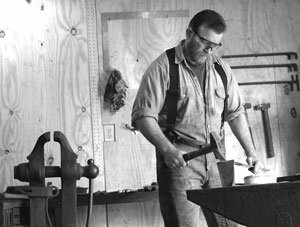
PHOTO BY JEN FARIELLO
It's all about authenticity for blacksmith Gerald (pronounced with a hard G) Boggs. In the forge on the first floor of his Afton home, a coal fire burns brightly, a massive anvil sits nearby, and the tools of his trade– primarily hammers of different sizes– hang on one wall. A coal fire burns red hot next to a barrel of water Boggs uses to cool red hot steel. Bogg himself, burly with bulging biceps, a barrel chest, and a full beard, looks like he could have stepped out of the past. In fact, in this room the only modern touch may be stereo speakers– but even these provide a touch of historic ambience as Dvorak's New World Symphony– composed in 1893– blasts out.
"My peers mock me as a purist, like it's a bad thing," scoffs Boggs, who says he is the only blacksmith in Virginia and one of only two in the country to entirely shun modern tools and methods in his craft, preferring instead a two and a half pound hammer to perform tasks such as "drawing down," which is to reduce the metal's thickness by striking it with a hammer and "up-setting," which is to increase thickness.
The experience of wielding a hammer over red-hot metal is something Boggs says he cherishes.
"It brings me closer to the metal when I'm working with hand tools," he says.
Boggs began his training in 1988 while still in the Navy, learning the craft on weekends from various metalworkers. He retired from the military in 1997, after nearly two decades, and worked as a cook aboard tall ships, using only historically accurate cooking methods for the next several years. His love of history and fascination with metal endured, however. In 2004 he sold his house in Orange to set up his Afton complex. While he still considers himself just a "journeyman," Boggs' work has attracted the attention of architects and builders interested in creating historically accurate metalwork for renovations or new construction.
Anyone who hires him can be sure Boggs won't hurry the process or change his mind about his historic methods.
"Using modern tools to mimic hand forged metal, to me," says Boggs, "is an abomination."
ANNE SCARPA MCCAULEY
BASKETWEAVING
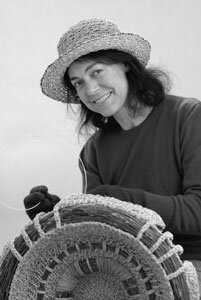
Anne Scarpa McCauley
PHOTO BY JEN FARIELLO
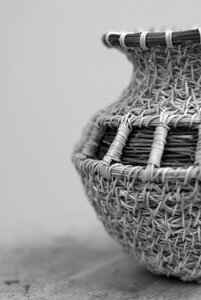
PHOTO BY JEN FARIELLO
Anyone who thinks basketweaving is a college course for lazy minds hasn't seen Anne Scarpa McCauley's handiwork. Working exclusively with one of nature's most common vines, McCauley creates everything from basic bracelets to simple circular baskets to vaselike constructions complete with "flowers" sculpted from vines. Despite the complexity of some designs, McCauley says she uses only two tools, her own hands, and one plant: honeysuckle.
"I pick all the honeysuckle for the year at one time," says McCauley, who says the vines at her Free Union home replenish themselves each year and provide another bonus: no overhead.
After she harvests honeysuckle, she creates the coils, sometimes using skinned honeysuckle, which starts out green and eventually yields a golden hue, and sometimes using unskinned honeysuckle, which always retains its dark brown shade.
It's a process McCauley has honed for more than 30 years, after discovering her talent as a child growing up just two miles from her current home.
"When I was 12, I decided to make a basket, and quite by mistake I came up with my coil pattern," says McCauley, who remarkably has never strayed from that pattern– now the building block for complex creations she could only imagine as a girl.
"I had a lot of trouble at first, but somehow I was persistant," she says. "I never stopped dreaming."
These days, McCauley's creations are sold at boutiques up and down the East Coast, and online at honeysucklebaskets.com. While her small bracelets start at just $4, her priciest pieces can go for $3,000.
This past holiday season, McCauley set up a stand on the Downtown Mall and got a special thrill: the woman who purchased the second basket McCauley ever made– more than three decades ago– stopped by with some good news.
"She said it's still in great shape," says McCauley.
HEATHER BELLE ROLFE
CALLIGRAPHY
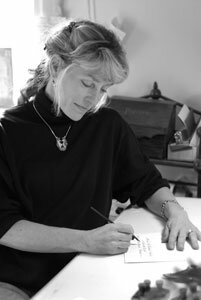
Heather Belle Rolfe
PHOTO BY JEN FARIELLO

PHOTO BY JEN FARIELLO
When the overseers of Monticello need historic penmanship for envelopes, diplomas or other documents, they turns to Heather Rolfe. So does UVA, which hired Rolfe to address 2,000 envelopes this past summer to prepare for the September kick-off of its capital campaign. And so have countless brides looking for a classy way to announce their nuptials. In fact, ask around, and when it comes to finding a top calligrapher in town, you'll likely find Rolfe– who does her work under the name Heather Belle Ink.
Watching her dip her pen "nib" into an ink well– filled with ink Rolfe has ground herself– and then quickly whip out several scrolling letters, it's hard to believe that, growing up, penmanship was not Rolfe's strongest suit.
"I had okay handwriting," she says, "but I always admired beautiful letters and writing." In fact, it wasn't until college, some 30 years ago, that Rolfe got bitten by the calligraphy bug.
"I was a botany major taking a design class when I saw an old English chart," Rolfe recalls. "It triggered something in me."
A New Yorker, Rolfe spent the summer after her freshman year commuting from her Long Island home into Manhattan to take calligraphy classes. Several years later, after moving to Florida and joining a calligraphers' guild, Rolfe says she got serious about the craft.
She moved to Charlottesville 16 years ago, and in that time, she says she's built a steady business, working out of a studio in her Belmont home. Being approached by Monticello, she says, was "a great honor," as was inscribing a statesmanship award for Margaret Thatcher, who visited Monticello in 1996.
Though most of her work is for lower profile recipients, Rolfe– whose two sons are now in college– says she's enjoying her work more than ever before.
"I can't be happier than when I'm at my desk," she says. "I almost feel guilty."
BARBARA GENTRY
SPINNING AND WEAVING
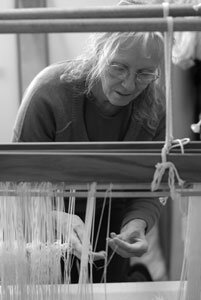
Barbara Gentry
PHOTO BY JEN FARIELLO
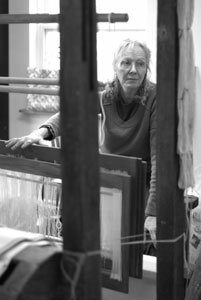
PHOTO BY JEN FARIELLO
Wandering around the Stony Mountain Fibers studio at Barbara Gentry's home off route 20N brings fairy tales to mind. The antique spinning wheels conjure images of Rapunzel spinning gold and Snow White's pricked finger. Appropriately, perhaps, Gentry says she was spellbound the first time she spotted a spinning wheel in the Hardware Store restaurant back in the late 1970s.
"It spoke to me," she says. "Loudly."
Gentry listened, and it wasn't long before she'd purchased her own wheel and was taking classes in spinning and weaving from Piedmont Virginia Community College and in the slave quarters at Ash Lawn-Highland.
"I was so nervous it was unreal," she recalls, "but it felt right."
In 1989, Gentry went into business and for the last 17 years she has been spinning wool from her own flock of American Cormo sheep and weaving and dyeing fabrics.
She does much of her weaving on a loom that dates to the 19th century– a complex and massive contraption with hundreds of threads that Gentry handles almost as though she were playing a harp.
While she sells a variety of yarn, knitting and other sewing materials in her shop, her first love remains authentic handmade materials.
Her sheep are shorn once a year in February by a man who travels from Vermont and uses traditional hand clippers, something she says stresses the sheep less and provides a better product by reducing the number of "second cuts," places where clippers have cut the same hairs twice.
She washes and combs the wool herself, using no chemicals, which she says cuts down on allergic reactions.
"Some people who think they're allergic to wool are actually allergic to the chemicals used to purify the wool in factories," she explains.
CHARLES MCRAVEN
TIMBERFRAMING
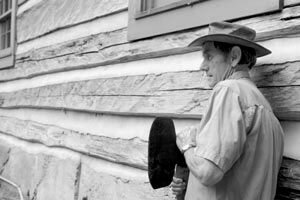
Charles McRaven
FILE PHOTO BY JEN FARIELLO
Some of Charles McRaven's earliest work might soon qualify for historic status in its own right. "I've been doing this for 50 or 60 years," says McRaven, who first restored a log cabin with his father and brother right after WWII. Two years later, the trio built a stone house, and from that point on, says McRaven, "I got hooked on craft stuff."
McRaven worked his way through college doing construction, and though he taught journalism at the college level for nine years until 1975, "I recovered from that," he laughs. Since then, he's restored countless historic homes and completed numerous new construciton projects, including a covered bridge near Free Union.
McRaven, 71, is currently focused on timberframe work. A grant from the Virginia Foundation for Humanities has enabled him to create an apprentice program, and he and two protegés are working on building a timberframe house they started in November and which they hope to finish by summer.
"We start with standing timber," says McRaven. "Shaking the squirrels out of the trees is the first thing we do," he jokes.
From there, McRaven says he teaches his apprentices to use the traditional tools of the trade– a broad axe for hewing timbers, and an adze for smoothing the timbers. He uses mortis chisels for cutting mortises– cavities in the wood– and tenons, which fit into the mortises. The two are the basis for timberframe and post-and-beam construction.
While McRaven says he prefers teaching "joinery," the use of old-style techniques– eventually he does allow apprentices to use modern tools. "As they progress, we cheat a little and go into modern chain saws because that's much faster."
In addition to apprenticeships and several weeklong workshops he offers each year, McRaven has also managed to combine his love of writing with his passion for historic building by putting out six books– one on blacksmithing, one on log cabins, and two on stonework. His third book on stonework will be published this spring by Storey Communications.
"I like to mix the cerebral stuff with the handwork," he says. "It keeps me from being bored with either one."
#